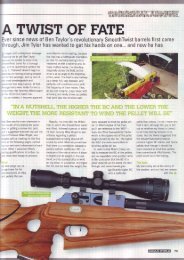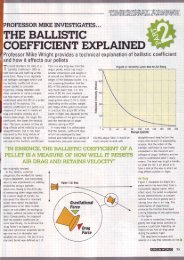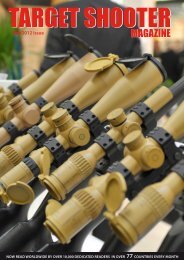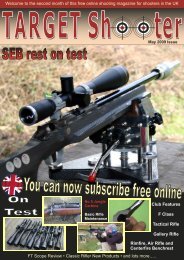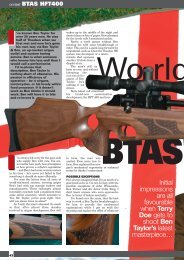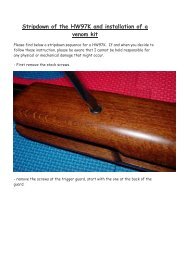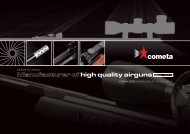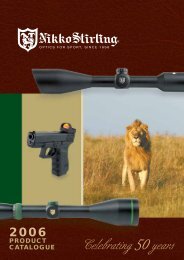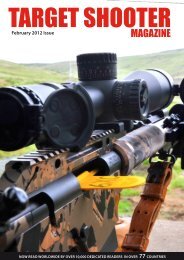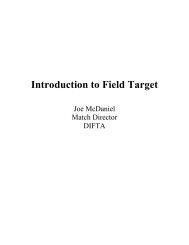Target Shooter 1
Target Shooter 1
Target Shooter 1
Create successful ePaper yourself
Turn your PDF publications into a flip-book with our unique Google optimized e-Paper software.
A typical modern 7.62mm TR rifle – David Archer’s<br />
Norman Clark built Barnard. David was impressed<br />
by the RUAG ammunition’s long-range<br />
performance in this year’s ‘Imperial’<br />
match numbers from certain years. Eventually, the<br />
US Army caught up and commissioned Sierra to<br />
design a bullet with the 173gn model’s excellent<br />
ballistic properties allied to the 168gn SMK’s superb<br />
accuracy – result the current 175gn MatchKing used<br />
by handloaders, commercial ammunition producers,<br />
and loaded in the military 7.62mm M118LR sniper /<br />
target cartridge. So, we have the interesting situation<br />
that US shooters in their primary NRA controlled rifle<br />
discipline used military rifles, albeit much enhanced<br />
in the accuracy influencing bits, but put quality<br />
commercial match ammo or handloads through<br />
them, while we used increasingly specialised and<br />
expensive custom built single-shot precision rifles,<br />
but limited their performance by insisting on cheap<br />
ammunition best restricted to belt-fed machineguns!<br />
So what did we use? ‘Selected’ batches of run<br />
of the mill military 7.62 followed by the ‘superior’<br />
(for that read ‘less bad’) RG ‘Green Spot’ sniper<br />
round that used the light military FMJBT bullet<br />
Many shooters handload precision .308W ammunition for their 7.62mm<br />
tactical rifles. Simon Rodgers used this Accuracy International Model AE<br />
successfully in early F-Class<br />
with the base cavity topped<br />
up with a little lead and<br />
weighing 146gn. Variations<br />
between production lots were<br />
significant, and even those<br />
selected after range-testing<br />
by the NRA could produce<br />
unpredictable fliers in<br />
prestigious events like<br />
the ‘Imperial’. Rifles were<br />
tailored to the ammunition<br />
with tight-bores, not only to<br />
suit the bullet diameter but<br />
to maximise MV, the light<br />
projectile unable to stay<br />
supersonic at long range, and<br />
a key feature was the use<br />
of a slow 1-14” rifling twist<br />
to suit the short bullet and<br />
reduce the rate of spin to the<br />
lowest level that still stabilised it to reduce dispersion.<br />
155gn<br />
Eventually, somebody in the MoD discovered<br />
‘Palma Rifle’, a long-range civilian discipline<br />
restricted to .308 Win and employing the<br />
ballistically efficient Sierra 155gn HPBT ‘Palma<br />
MatchKing’ bullet that far outperformed the NATO<br />
projectile. The then government owned Radway<br />
Green facility was commissioned to design an<br />
FMJBT version for use in a new sniper round<br />
to let the L96A1 (Accuracy International Model<br />
PM) rifle achieve its potential, defined as a high<br />
probability first shot hit at 800 metres. The resulting RG<br />
‘Bisley Match’ round became the mainstay of UK TR<br />
shooting for several years, and while a huge<br />
improvement over its 146gn ‘Green Spot’<br />
predecessor, was still inferior accuracy-wise, and<br />
to a certain extent ballistically to commercial or<br />
handloaded cartridges using Sierra or other<br />
HPBT Palma match<br />
bullets. This era<br />
ended abruptly last<br />
year when RG’s post<br />
privatisation owner<br />
BAe withdrew from<br />
the civilian market,<br />
and the MoD<br />
terminated the<br />
l o n g s t a n d i n g<br />
practice of paying<br />
for military use of the<br />
Bisley ranges through<br />
ammunition supplies.<br />
After a year-long<br />
testing and tendering<br />
process, the NRA<br />
awarded a contract<br />
<strong>Target</strong> <strong>Shooter</strong> 71



